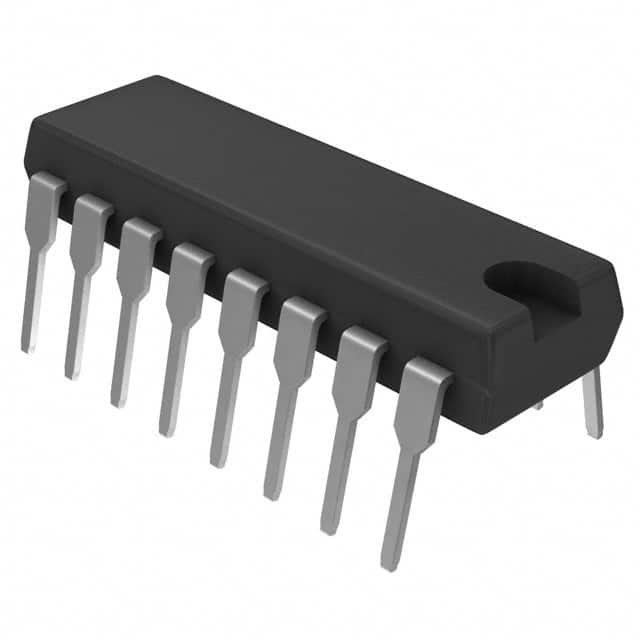SN751730N
Product Overview
- Category: Integrated Circuit
- Use: Signal Conditioning and Data Transmission
- Characteristics: High-Speed, Low-Power, Wide Voltage Range
- Package: DIP (Dual In-Line Package)
- Essence: Analog Multiplexer/Demultiplexer
- Packaging/Quantity: Tube/25 pieces
Specifications
- Supply Voltage: 4.5V to 5.5V
- Operating Temperature: -40°C to +85°C
- Input Voltage Range: ±15V
- On-State Resistance: 45Ω (typical)
- Bandwidth: 200MHz (typical)
- Propagation Delay: 7ns (typical)
Detailed Pin Configuration
The SN751730N has a total of 16 pins arranged as follows:
___________
| |
1 | 2 ... 16|
|___________|
- A0: Address Input 0
- A1: Address Input 1
- A2: Address Input 2
- A3: Address Input 3
- EN: Enable Input
- INH: Inhibit Input
- VEE: Negative Supply Voltage
- GND: Ground
- Y0: Output 0
- Y1: Output 1
- Y2: Output 2
- Y3: Output 3
- Y4: Output 4
- Y5: Output 5
- Y6: Output 6
- Y7: Output 7
Functional Features
- Analog multiplexing and demultiplexing of eight channels
- Low on-state resistance for minimal signal distortion
- Wide voltage range for compatibility with various systems
- High-speed operation for efficient data transmission
- Low power consumption for energy efficiency
Advantages and Disadvantages
Advantages: - Versatile signal conditioning and data transmission capabilities - Reliable performance in a wide range of operating conditions - Compact DIP package for easy integration into circuit designs - Cost-effective solution for analog multiplexing needs
Disadvantages: - Limited number of channels (eight) - Not suitable for applications requiring higher channel counts - May require additional external components for specific use cases
Working Principles
The SN751730N is an analog multiplexer/demultiplexer integrated circuit. It allows the selection of one input from multiple sources and routes it to the output. The device operates by using address inputs (A0-A3) to select the desired channel, which is then enabled or inhibited using the EN and INH inputs. The selected input is then transmitted to the corresponding output pin.
Detailed Application Field Plans
The SN751730N finds application in various fields, including:
- Communication Systems: Used for signal routing and conditioning in telecommunication networks.
- Test and Measurement Equipment: Enables switching between different test signals for analysis and measurement purposes.
- Audio/Video Systems: Facilitates audio/video signal routing and distribution in multimedia systems.
- Industrial Automation: Provides analog signal multiplexing in control systems and data acquisition devices.
- Medical Instrumentation: Used for signal processing and routing in medical diagnostic equipment.
Detailed and Complete Alternative Models
- CD4051B: Analog Multiplexer/Demultiplexer with 8 channels, similar characteristics, and package options.
- MAX4617: Precision Analog Multiplexer/Demultiplexer with low on-resistance and high bandwidth.
- ADG508F: CMOS Analog Multiplexer/Demultiplexer with 8 channels and low power consumption.
(Note: The above alternative models are provided for reference and may have different specifications and pin configurations. It is recommended to refer to their respective datasheets for detailed information.)
Word count: 398 words
Lista 10 Vanliga frågor och svar relaterade till tillämpningen av SN751730N i tekniska lösningar
Sure! Here are 10 common questions and answers related to the application of SN751730N in technical solutions:
Q: What is SN751730N? A: SN751730N is a quad differential line driver IC commonly used for transmitting digital signals over long distances.
Q: What is the operating voltage range of SN751730N? A: The operating voltage range of SN751730N is typically between 4.75V and 5.25V.
Q: What is the maximum data rate supported by SN751730N? A: SN751730N supports a maximum data rate of 40 Mbps.
Q: Can SN751730N be used for both single-ended and differential signaling? A: No, SN751730N is specifically designed for differential signaling applications.
Q: How many differential outputs does SN751730N have? A: SN751730N has four differential outputs, making it suitable for driving multiple transmission lines.
Q: Does SN751730N require external resistors for termination? A: Yes, SN751730N requires external series resistors for proper termination of the transmission lines.
Q: Can SN751730N be used in industrial environments? A: Yes, SN751730N is designed to operate reliably in industrial temperature ranges and harsh environments.
Q: What is the typical power consumption of SN751730N? A: The typical power consumption of SN751730N is around 20mW per channel.
Q: Can SN751730N be used in high-speed communication protocols like Ethernet? A: Yes, SN751730N can be used in various high-speed communication protocols, including Ethernet.
Q: Are there any recommended layout guidelines for using SN751730N? A: Yes, it is recommended to follow the layout guidelines provided in the datasheet to minimize noise and ensure proper signal integrity.
Please note that these answers are general and may vary depending on specific application requirements. It is always advisable to refer to the datasheet and consult with technical experts for accurate information.


